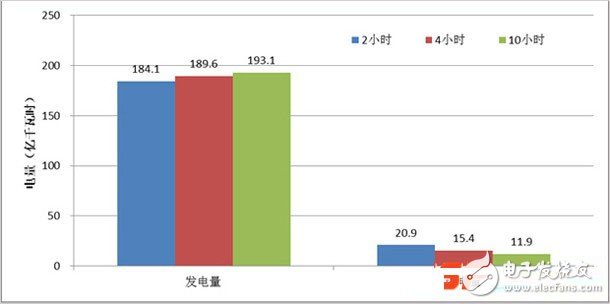Wang Weixun, director of the New Energy Research Institute of China Electric Power Research Institute, gave a speech on the theme of "The role of solar thermal power generation in the integration of new energy sources" at the China Solar Thermal Power Generation Conference. He simulated the impact on the PV reception capacity of the grid after a certain proportion of CSP installations were installed for the PV system.
He pointed out that China is the country with the largest and fastest growing new energy sources in the world. Wind power grid-connected capacity has increased 100 times in 10 years, and photovoltaics has increased 100 times in 5 years. New energy has become China's third largest power source. In 2030, new energy will become the second largest power source in China. However, in contrast, the problem of safe operation of large-scale new energy centralized access to the power grid in China is prominent, and new energy power generation units have been disconnected from the network. Due to insufficient peaking capacity and limited transmission section, and the uncertainty, volatility and non-storability of new energy resources, the wind/light phenomenon is inevitable.
At present, the problem of grid connection of new energy in China has become more and more serious. If the stability of new energy power generation cannot be increased, so that it can effectively participate in peak shaving, it will be difficult to achieve a higher proportion of new energy grid-connected machines. Wang Weisheng believes that the adjustable new energy power of solar thermal power has a direct positive impact on the photovoltaic capacity of the grid.
Taking a certain area in the northwest as an example, if the installed capacity of photovoltaics in 2020 is 10 million kilowatts, the projected light rejection rates in 2015 and 2020 are expected to be 4.37% and 7.48%, respectively. This indicates that with the further expansion of the installed capacity of photovoltaics, the light rejection rate has further increased.

Further research shows that on the basis of 10 million kilowatts of photovoltaic planning installed capacity in 2020, 2 million kilowatts of photovoltaic and photothermal installed capacity will be added respectively. The light rejection rates under the two scenarios are 13.02% and 10.17%, respectively. This means that the addition of a solar thermal installation can significantly reduce the photovoltaic rejection rate.

For 10 million kilowatts of photovoltaic + 2 million kilowatts of photothermal installation, considering the different heat storage time (2h, 4h and 10h) of the thermal power station, the light rejection rates in the three scenarios are 10.17%, 7.53% and 5.82%, respectively. This highlights the value of the CSP thermal storage system. The longer the heat storage time, the greater the gain on the on-grid power of the overall solar power plant.

Taking 10 million kilowatts of photovoltaic + 2 million kilowatts of photothermal as an example, assuming that (4 million kilowatts of photovoltaic + 2 million kilowatts of light and heat) are located in the same area, the power generation output of the solar thermal power station with different heat storage time (2h and 10h) is as follows. . Above is the output of the 2-hour thermal storage thermal power station, and below is the output of the 10-hour thermal storage thermal power station. The output of the weather is better (left curve) and the weather is not good (right curve).

The following picture shows that under the 10 million kilowatt photovoltaic + 2 million kilowatts photothermal installation, assuming that (4 million kilowatts of photovoltaic + 2 million kilowatts) of light and heat are located in the same area, with different heat storage time (2h and 10h) of the solar thermal power station, Output power diagram of a 4 million kilowatt photovoltaic power station. The upper side is the output diagram of the photovoltaic power station with a 2-hour thermal storage thermal power station, and the lower side is the output diagram of the photovoltaic power station with a 10-hour thermal storage thermal power station. The output of the weather is better (left curve) and the weather is not good (right curve). It can be seen from the figure that when the 10-hour heat storage thermal power station is equipped, the photovoltaic light rejection rate is significantly reduced.

The hybrid development of photovoltaic and solar thermal power generation projects can reduce the investment cost of the overall project. At the same time, the special advantages of light and heat can be used to bundle the photovoltaics with the photovoltaics, effectively reducing the light-emitting rate of photovoltaic power generation, and meeting the power market for sustainable. The need for power supply. This hybrid development model has many cases around the world. For example, the CSP/PV hybrid power supply project planned by Solar Reserve in Chile, the Redstone solar thermal power station developed in South Africa (next to the 75MW Lesedi photovoltaic power station and the 96MW Jasper photovoltaic power station).
The main control unit of the equipment is PLC and the HMI (Human Machine Interface) is 7" LCD colorful touch screen. The equipment has varieties of operating modes, and can automatically record and save working status.
The complete set of equipment is easy to operate, reliable in working, complete in protection and high in automation.
Fast Charging,Intelligent Fast Battery Charger,Agv Automatic Battery Charger,Agv Fast Charger
Xinxiang Taihang Jiaxin Electric Tech Co., Ltd , https://www.chargers.be